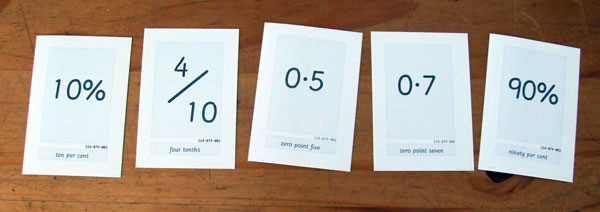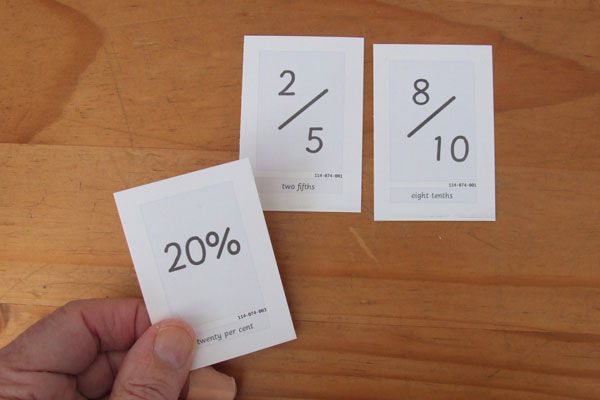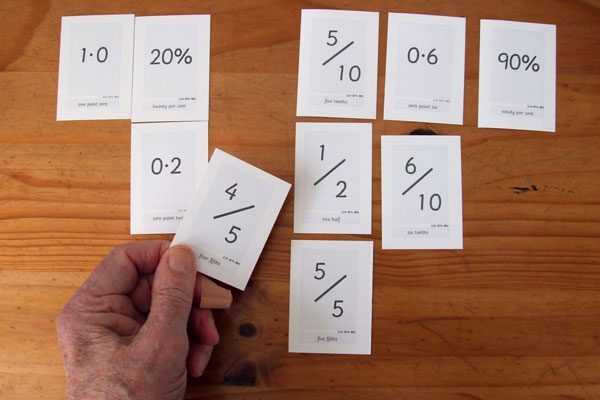
Busy Fractions Decimals and Percents ~
Lesser on the left ~ Greater on the right
This is a 'freedom' exercise, in that the task varies ~ and so do the answers. This means that self-checking answers is difficult. If several students work together, they can check each other.
I have suggested one way to play ~ there must be several other ways of testing each other.
These instructions apply to several types of card ~ fractions ~ decimals ~ percentages (illustrated) ~ or Arabic numbers ~ Roman Numerals ~ or lengths mm,cm,m,km ~ or any thing with size or value attached to it. See the note and links at the foot of this page.
An appropriate selection of cards is shuffled and laid out in a pile ~ face down. The top card is turned-up and placed centrally on the table. Players take it in turns to take a card and place it ~ in a line ~ face up ~ close to the first card on the table. The line is a value of the number line ~ the least at one end ~ the greatest at the other. The lesser and greater ends of the line ~ eg left and right ~ must be agreed beforehand. Every card is to be placed such that the cards the one side are less in value ~ those on the right are greater in value.
The next card that is drawn must be placed at the appropriate place ~ lesser or greater than the ones already in the line.


If a card is equal in value to a card that is already there then it is placed adjacent to that card.
Sometimes the line will need to be broken ~ so that a card can be made to fit between two others of greater and lesser value. I have called that placing the card inside the line.
This picture shows a diagram of game in progress ~

Players could score a point for each card correctly placed. Misplaced cards score nil ~ a player who notices an error gains a bonus point and ~ or ~ has the next turn. Supervisors can invent appropriate rules and credits. Please remember the main ~ partly hidden ~ motive is mathematics ~ not competition.
The set of cards as printed includes some extras that should be excluded ~ equivalent fractions such as 2/5 and 4/10 are best left out at first. The picture below requires careful thought ~

With practice and forethought students may leave appropriate spaces in the knowledge that they are likley to be filled as things progress. Otherwise there has to be some pushing around of the cards to make room as it is required.

Instead of taking cards from the central stack players could have five cards each ~ playing them one at a time from a face-down pile ~ or looking at the cards face-up ~ and playing a card as and when it seems appropriate.
A pre-prepared selection of cards is necessary for this activity. Printed sheets of suitable cards are available ~
~ Decimals ~ Fractions ~ Percentages ~ to one place (as shown in use, above) [114074].
~ Lengths ~ mm ~m ~km [**]. Not yet ready.
~ Numerals ~ Arabic ~ Roman ~ Domino [**]. Not yet ready.
Other activites related to these cards are available ~
A pelmanism type of game [114066].
A version of Snap to help with interchangeability between fractions ~ decimals ~ percentages [114069].
